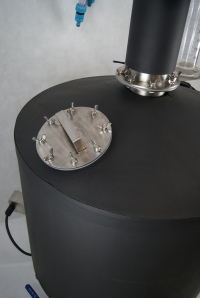About iStill insulation
30 June 2013
Why are iStills insulated with a 13 millimeter thick cocoon insulation? You ask, Odin answers.
There are two main reasons for why the insulation is there. The first and most important reason is that the insulation shields the iStill from external influences. An non-insulated boiler will be cooled by the air in the room, or - when you distill outside - by a breeze. This unwanted cooling creates extra passive reflux, both in the boiler and into the column.
Gasses rising from the liquid need to enter the column. We especially designed the top of the boiler to be conical, so gasses boiling up will automatically find the entrance to the column. But in a non-insulated boiler, the top (conical or not) will be cooled. This cooling will condense part of the gasses. The gasses that condense do not enter the column. They just fall back into the liquid. That's called passive reflux, because this extra reflux (of gasses being liquified and then returned to the boiler) is not managed. In a non-insulated boiler, it just happens. And when it happens, it will lower the efficiency of the distillation process.
Same thing with an non-insulated column. The external temperature cools the column wall which, in turn, causes more gasses to be liquified. Again, passive reflux lowers efficiency.
That's why all iStills are insulated. The insulation makes for a more efficient distillation process.
But there is another, a second reason why we always insulate our columns and boilers. Energy input versus energy loss. A non-insulated boiler and column will give off a lot of heat. That heat - energy actually - is used to warm up the environment of the still, rather than the liquids and gasses in the boiler and column. Again, insulation improves efficiency, since losses due to "heat leakage" are minimized.
So how important is insulation? What kind of energy or efficiency gains can obtained by the iStills cocoon insulation? Well, we wouldn't be called iStill, if we hadn't tested it. By comparing a non (not yet, actually) insulated iStill 50 to an insulated one. The tests showed us that insulation improves efficiency by 15% when you distill inside, at room temperature. Energy savings (or efficiency gains - just from what perspective you look at it) in an external, cooler, slightly windy situation show benefits of 25%.
When we forget about the math for a moment, and put it down in layman's terms, an insulated iStill will finish a run 15 to 25% faster than a non-insulated one. By adding insulation, you will save 15 to 25% in energy costs.
www.iStill.eu
Reactions
Add your comment
All reactions ()
Loading comments..
